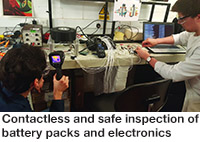FLIR tools help students prepare for SpaceX competition
30/10/2018
Here is a challenge: build your own Hyperloop pod prototype and test it at Elon Musk’s SpaceX headquarters in California. Who said engineering cannot be fun? Engineering students from the University of Edinburgh who were accepted to participate in the exciting SpaceX Hyperloop Pod competition used thermal imaging and measurement technology from FLIR to make sure their prototype was ready for the race.Travelling from city to city at 700 mph in an underground vacuum tube seems futuristic to some of us, but not to entrepreneur Elon Musk. The forward-thinking CEO of Tesla and SpaceX sees this as the next step in mass transportation technology. Hyperloop is Musk’s concept of electrically propelled pods travelling autonomously through a near-vacuum tube. The pods will be able to reach speeds comparable to aircraft and could see a journey such as Edinburgh to London shortened to 50 minutes.
A yearly competition draws many engineering teams from around the world to the SpaceX headquarters in California. There, SpaceX challenges the teams to develop their own Hyperloop pod prototype and test it in a mile-long vacuum tube.
One of the engineering teams that joined the 2018 competition is HYPED, a student society at the University of Edinburgh. The team, consisting of more than 100 members, has been focusing on both the technical and commercial development of Hyperloop. Their designs have already seen success in two international competitions.
In the 2018 competition, the HYPED team wanted to push the boundaries of the Hyperloop technology in a new prototype that featured magnetic levitation, electrodynamic (Halbach) wheels for propulsion and high-speed braking, emergency pneumatic brakes and a carbon composite pressurised vessel.
“As a student society, our budgets and capabilities are rather limited,” said Daniel Toth, Head of Power at HYPED. “The first time we can actually test our prototype on a larger scale is at the SpaceX facilities. So, it is very important that we can thoroughly test every individual component well in advance, starting with smaller test set-ups but then gradually increasing the size of our tests.”
Daniel heads the group involved with power management (battery packs and related electronics), which is usually an area of expertise in which things heat up before they break. Next to a lot of simulation work, the HYPED team also performs destructive tests of components to discover the performance limits of their designs.
“With electrical components and battery packs, heat usually indicates that something goes wrong, so it is only logical that thermal imagers are part of our toolkit,” Daniel explained. “Thermal imaging is an ideal technology to see weak points in the design and it enables us to see where we can make improvements. Electronic components will also behave differently in a vacuum, because there is no air cooling. It is important to test these conditions very thoroughly.”
 The HYPED team has been using a FLIR E4 thermal imaging camera and a FLIR CM275 clamp meter with thermal imaging.
The HYPED team has been using a FLIR E4 thermal imaging camera and a FLIR CM275 clamp meter with thermal imaging.“We found that the FLIR CM275 clamp meter is great for quick scanning and diagnostics, while the FLIR E4 thermal camera is handier for longer and more comprehensive inspections that involve more people,” said Daniel.
The power of the FLIR CM275 clamp meter lies in the fact that it combines two modes of operation that work well together. Through Infrared Guided Measurement (IGM™), the CM275 provides a reliable way to identify hotspots and overloaded circuits from a safe distance. With the clamp meter’s wide range of functions and accurate temperature readings, users can confirm their findings.
“Even in thermal imaging mode, you can still use the meter readings, so having both in one device is very efficient,” said Daniel. “To me, it is much more reliable when you can crosscheck your results between different modes of operation.”
Working with batteries always includes risks as batteries contain toxic liquids and charging them with high currents will cause them to heat up. The plastic casing of cables leading to the interface is especially vulnerable to melting or catching fire.
In the worst case, batteries will vent, which means that they can suddenly release dangerous gases and liquids when under pressure.
With conventional tools, such as thermistors or thermocouples, the user needs to take measurements with the tool contacting the object of research. Thermal imaging cameras offer the HYPED team a way to inspect battery packs and electronics from a safer distance, without making contact.
Daniel also owns a FLIR ONE® thermal imager for smartphones, a tool that he claims really taught him to appreciate the power of thermal imaging.
“Having worked with electronics for quite some time now, thermal imaging has always come in handy for electronics inspections. That is why I am looking forward to using the FLIR tools for even more applications.”
Testing of the prototype’s propulsion system and motor control unit is on the HYPED team’s to-do list. This team needs to cool all of these systems efficiently, a task that Daniel believes can really show the value of thermal imaging.
“Building a prototype during a one-year competition can be stressful at times but, fortunately, tools such as thermal imaging cameras and clamp meters help us to stay on schedule and make reliable measurements.”
www.flir.com